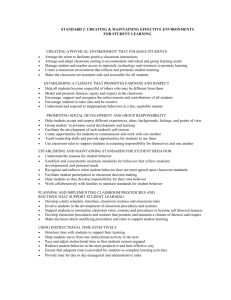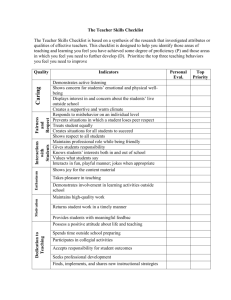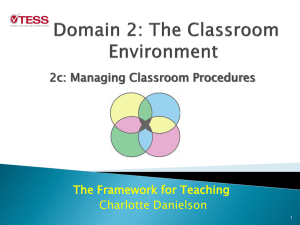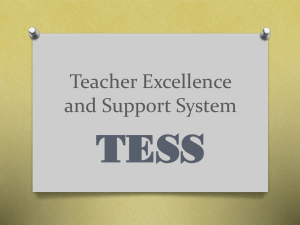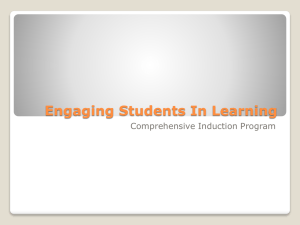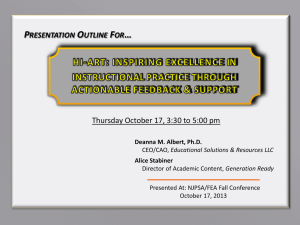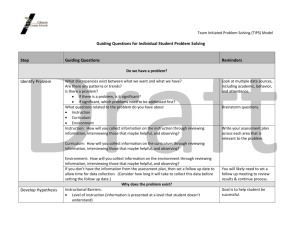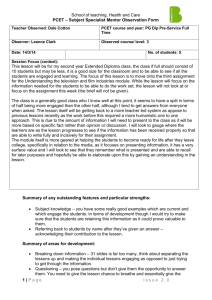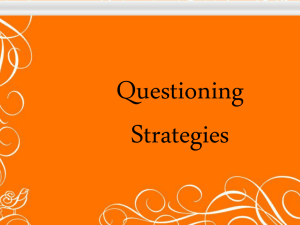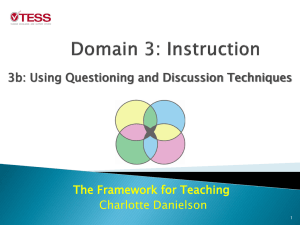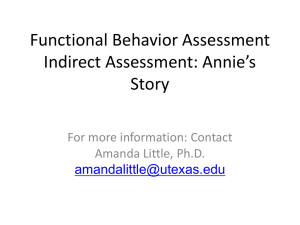students - Associated Professional Educators of Louisiana
advertisement
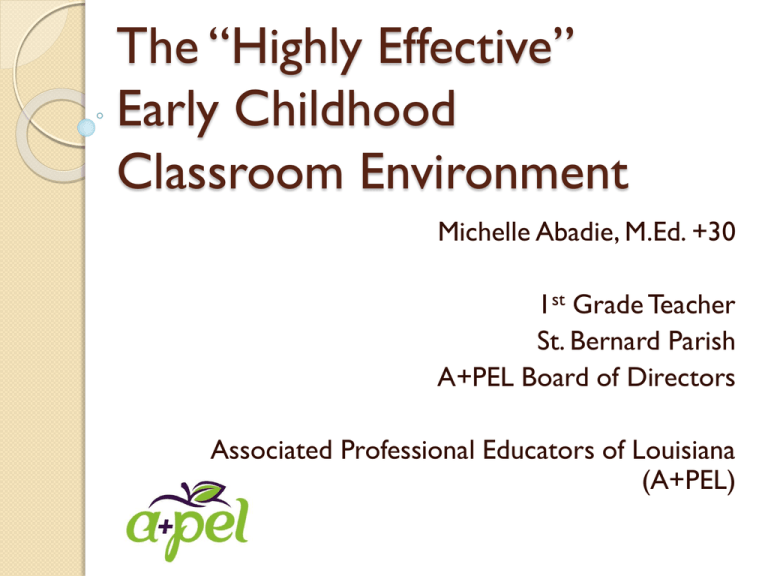
The “Highly Effective” Early Childhood Classroom Environment Michelle Abadie, M.Ed. +30 1st Grade Teacher St. Bernard Parish A+PEL Board of Directors Associated Professional Educators of Louisiana (A+PEL) FYI: This is an informational presentation covering aspects of COMPASS ◦ Not an endorsement or criticism of policy All information is publicly available. http://www.louisianabelieves.com/teaching /compass PROFESSIONAL PRACTICE COMPASS Observation Rubric Based on Danielson’s Rubric for Effective Teaching Domain I: Setting Instructional Outcomes Domain 2: Managing Classroom Procedures Domain 3: Using Questioning/Discussion Domain 4: Engaging Students in Learning Domain 5: Using Assessment in Instruction Domain 1: Setting Instructional Outcomes What would this domain look like in a classroom? ◦ Example of this domain in action? Outcomes: ◦ How should they be communicated to students? ◦ What should they represent? Effective (3) Outcomes represent high expectations and rigor. Outcomes are related to “big ideas” of the discipline. Outcomes are written in terms of what students will learn rather than do. Highly Effective (4) Teacher plans blueprints to ensure accurate sequencing. Teacher connects outcomes to previous and future learning Outcomes are differentiated to encourage individual students to take educational risks Instructional Outcomes Domain 1: Setting Instructional Outcomes (See Example Lesson Plan) ◦ “The students will learn and apply their [previous] knowledge/ skills to…” ◦ *Differentiate outcomes to individual students. ◦ Have students participate in identifying the outcomes/ goals of the lesson. ◦ Incorporate standards from across the curriculum. Domain 2: Managing Classroom Procedures What would a well managed classroom look like? ◦ What evidence can an observer use to rate classroom management? Effective (3) Highly Effective (4) The students are productively engaged during small group work. Transitions between large and small group activities are smooth. Routines for distribution and collection of materials and supplies work efficiently. Classroom routines function smoothly. Students take the initiative with their classmates to ensure that their time is used productively. Students themselves ensure that transitions and other routines are accomplished smoothly. Students take initiative in distributing and collecting materials efficiently. Classroom Procedures Domain 2: Managing Classroom Procedures “Knee to Knee” discussion technique & sticky notes to reflect on previous knowledge and informally assess understanding (not just raise your hand to discuss… strive for more whole group participation) Introduce a problem or activity that is set up for “students to take the initiative”. ALREADY have routines set so “students themselves ensure transitions/distributing materials are smooth” (I use group leaders, group points, count down, materials prepared, heads down to eliminate chaos) Domain 3: Using Questioning / Discussion How do you use Questioning and Discussion in a classroom? ◦ To whom should the students ask their questions? ◦ What methods can be used to foster discussion? Effective (3) Teacher uses open‐ended questions, inviting students to think and/or have multiple possible answers. The teacher makes effective use of wait time. The teacher builds on uses student responses to questions effectively. Discussions enable students to talk to one another, without ongoing mediation by the teacher. The teacher calls on most students, even those who don’t initially volunteer. Many students actively engage in the discussion. Highly Effective (4) Students initiate higher‐order questions. Students extend the discussion, enriching it. Students invite comments from their classmates during a discussion Questioning/Discussion Domain 3: Using Questioning / Discussion Introduce a problem which allows “students to take the initiative.” Make it exciting for them and make them feel like the leaders! Make it a REAL challenge related to their lives. Prepare activities for students to work independently and collaboratively. Have various materials for them to use to problem-solve for various learners. Allow for enough time! Monitor and assist with engagement by encouraging their peers to make suggestions--- not you! Close with a review which allows them to apply to real-life. Also, have students refer to learning goal and celebrate their achievements! Domain 4: Engaging Students in Learning How can you observe student engagement? What does an engaged classroom look like? How do we engage students? Effective (3) Highly Effective (4) Most students are intellectually engaged in the lesson. Learning tasks have multiple correct responses or approaches and/or demand higher‐order thinking. Students have some choice in how they complete learning tasks. There is a mix of different types of groupings, suitable to the lesson objectives. Materials and resources support the learning goals and require intellectual engagement, as appropriate. The pacing of the lesson provides students the time needed to be intellectually engaged. Virtually all students are highly engaged in the lesson. Students take initiative to modify a learning task to make it more meaningful or relevant to their needs. Students suggest modifications to the grouping patterns used. Students have extensive choice in how they complete tasks. Students suggest modifications or additions to the materials being used. Students have an opportunity for reflection and closure on the lesson to consolidate their understanding. Engaging Students Domain 4: Engaging Students in Learning Make it exciting for them and make them feel like the leaders! Make it a REAL challenge related to their lives. Prepare activities for students to work independently and collaboratively. Have various materials for them to use to problem-solve for various learners. Allow for enough time! Monitor and assist with engagement by encouraging their peers to make suggestions--- not you! Domain 5: Using Assessment in Instruction How do I use assessment in instruction? ◦ Methods to align? ◦ How do you check for understanding DURING a lesson? Effective (3) Students indicate that they clearly understand the characteristics of high quality work. The teacher elicits evidence of student understanding during the lesson Students are invited to assess their own work and make improvements. Feedback includes specific and timely guidance for groups The teacher attempts to engage students in self‐ or peer‐assessment. When necessary, the teacher makes adjustments to the lesson to enhance understanding Highly Effective (4) There is evidence that students have helped establish the evaluation criteria. Teacher monitoring of student understanding is sophisticated and continuous: the teacher is constantly “taking the pulse” of the class. Teacher makes frequent use of strategies to elicit information about individual student understanding. Feedback to students is specific and timely, and is provided from many sources, including other students. Students monitor their own understanding, either on their own initiative or as a result of tasks set by the teacher. The teacher’s adjustments to the lesson are designed to assist individual students. Assessment in Instruction Domain 5: Using Assessment in Instruction Positive feedback! (Teach students how to do this too!) Constantly monitor! (Listen to discussions and encourage students to assist one another.) Adjust lesson if necessary! (But students need consistency in routines to eliminate confusion to any changes, so you need to be strategic about this.) Great resource for video examples! http://videolibrary.louisianabelieves.com/ Videos show Compass ratings in various domains and explanations of evidence to determine the ratings. Additional Resources www.apeleducators.org www.youtube.com/apeleducators www.facebook.com/goapel www.twitter.com/goapel
